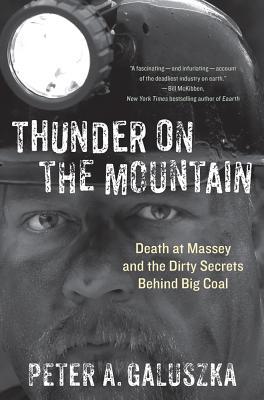

| THUNDER ON THE MOUNTAIN Death at Massey and the Dirty Secrets Behind Big Coal Peter A. Galuszka New York: St. Martin's Press, September 2012 |
Rating: 4.5 High |
|||
| ISBN-13 978-1-250-00021-7 | ||||
| ISBN-10 1-250-00021-1 | 283pp. | HC/BWI | $25.99 | |
"For Appalachia, coal is a curse and a prize. Since the nineteenth century, it has built cities, electrified houses, and been used for transportation and synthetic energy. It has also killed thousands of miners, ruined many lungs, polluted many streams, and bitten off huge chunks of some of the most beautiful mountains in the United States. Although coal's uses have shifted over the years—railroads no longer run on it nor are homes heated with it—more coal is produced than ever before, providing nearly half of all electricity generated in twenty-first-century America and building skyscrapers and highways in Shanghai and Mumbai." Coal's contradictions come together most tellingly in the form of one man, Donald Blankenship, a child of the Central Appalachians who was chairman and chief executive officer of America's fourth-largest coal firm, Massey Energy. Like the rawboned settlers in the hills of southern West Virginia and eastern Kentucky, Blankenship was tough, independent minded, and not at all beholden to whatever latest management fad was coming out of business schools. Even now, Blankenship makes no bones about breaking unions, telling environmentalists where to get off, bankrolling mountain politicians and judges, and resisting complaints of do-good "green investors" who were critical of Massey's poor safety record and devastating mountaintop-removal practices. – Pages 139-140 |
And Galuszka covers those contradictions very well. Foremost among them is that the region's most hazardous occupation is also its most popular. The rolling hills of Appalachia do not lend themselves to the large factories, densely populated cities and sprawling suburbs familiar to the rest of the country — or even to large-scale farming. In addition the mineral rights belong mostly to outside interests. The result is that mining coal is the best-paying job in most places, and there is little incentive to care for the quality of local communities or the long-term health of their people.
Blankenship contradicts this tendency, but only in the town of Matewan where he went to school and maintains a residence. The largess he dispenses there has the residents on his side. Elsewhere in the region he is looked on less favorably. Massey Energy under his leadership has been bluntly anti-union, anti-safety, and anti-environment. But he has provided employment for coal miners, and that is enough to guarantee their loyalty. That, and generous spending on local politics, kept him in the catbird seat at Massey. It looked like he would remain there.
All that changed on the morning of 5 April 2010. An explosion inside the Upper Big Branch mine killed 29 miners. The only thing remarkable about this disaster is that it is the most recent in the Appalachian coal fields. The death toll was not the highest. The cause was utterly commonplace: combustion of methane and coal dust, abetted by poorly maintained equipment.1 The result was also typical: no senior executives went to jail,2 and no mining regulations were strengthened because of the laxity on safety.
But the disaster depressed the company's market value, making its large coal reserves a tempting target for acquisition. Also, business culture was changing; Blankenship's bluntly confrontational style was becoming less acceptable. Certainly potential merger partners found it unacceptable. In the end, Alpha Natural Resources acquired Massey and Blankenship was forced out. Whether Alpha will pay more attention to safety remains to be seen.
Galuszka has done extensive research on this book. He not only delves into the history of Massey Energy, but examines coal use overseas, notably in Mongolia. I recommend this work, but I mark it down one notch because of its numerous instances of careless writing and unsupported statements, such as that the $350 million of President Obama's stimulus spent on clean energy has done no good, or that the president "really hasn't made much of a dent" in strengthening environmental protections. These assertions are simply wrong.

 To contact Chris Winter, send email to this address.
To contact Chris Winter, send email to this address.